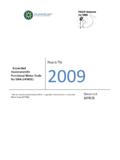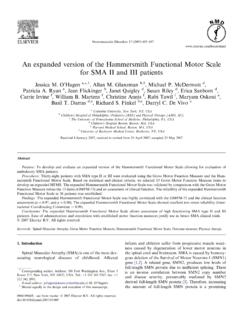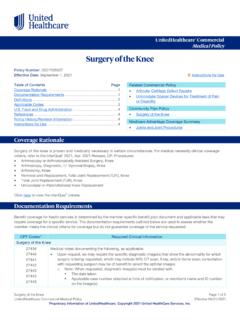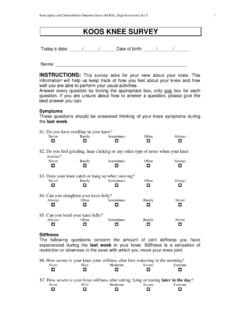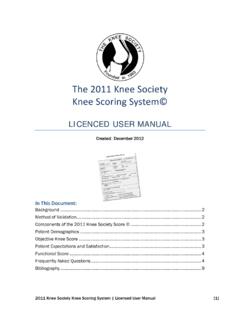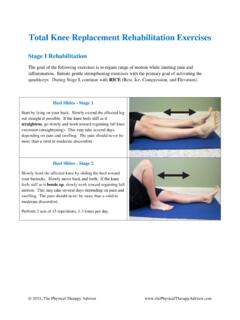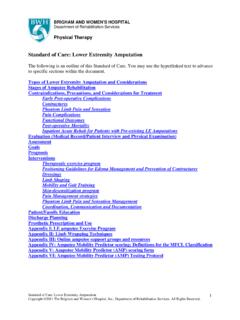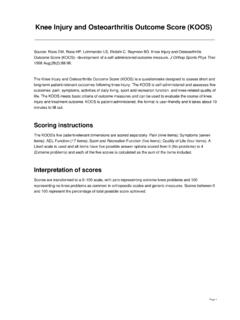Transcription of CHOP Intend for SMA Type I - columbiasma.org
1 CHOP Intend . CHILDREN'S HOSPITAL of PHILADELPHIA INFANT TEST OF NEUROMUSCULAR DISORDERS. Name: Diagnosis: MR: Gestational age: DOE: Time of evaluation: Time since last feeding: DOB: Current health: URI Gtube BIPAP HRS/Day____HRSoff BIPAP at testing____. Position Test Procedure Graded Response Score Item Supine Observe throughout Antigravity shoulder movement Best side: 1 testing (achieves elbow off surface). 4 L. Spontaneous Antigravity elbow movement movement May unweight limb or (achieves hand and forearm off surface). 3. (Upper stimulate infant to Wrist movement extremity) facilitate response 2 R State: Finger movement 1. No movement of limbs 0. Supine Observe throughout Antigravity hip movement Best side: 2 testing (achieves feet and knees off surface).
2 4 L. Spontaneous Antigravity hip adduction/internal rotation movement May unweight limb or (knees off surface). 3. (Lower stimulate infant to Active gravity eliminated knee movement extremity) facilitate response 2 R State: Ankle movement 1. No movement of limbs 0. Supine Grip strength: place Maintains hand grip with shoulder off bed Best side: 3 finger in palm and lift 4 L. Hand grip Maintains grip with elbow off surface 3. until shoulder comes (shoulders on surface). off surface observe when infant looses Maintains grip with forearm off surface 2. grasp (elbow supported on surface) R State: May use toy of similar Maintains grip only with no traction 1. diameter for older No attempt to maintain grasp children 0.
3 Supine head midline Visual stimulation is Rotates from maximum rotation to midline Best side: 4 given with toy. 4 L>R. Head in Turns head part way back to midline 3. If head is maintained midline with in midline for 5. visual Maintains midline for 5 or more seconds 2. seconds: Place head in State: stimulation* maximum available Maintains midline, less than 5 seconds R>L. rotation and provide 1. visual stimulation to Head falls to side, no attempts to regain encourage midline midline 0. Supine, no diaper Hips flexed and Keeps knee off surface of bed > 5 sec or lifts Best side: 5 adducted foot off surface 4 L. Hip adductors Feet hip width apart Keeps knees off surface of bed 1-5 sec and thighs parallel, 2 State: knees slightly apart No attempt to maintain knees off surface 0 R.
4 1. Holding infant's When traction is applied at the end of the 4 To R. 6 Supine lower thigh, flex hip maneuver, rolls to prone with lateral head Best side: Rolling: (arms at side) and knee and adduct righting elicited from Keep side tested up across midline Rolls through side lying into prone without legs* roll away from the bringing pelvis vertical lateral head righting, clears weight-bearing 3. Side tested maintain traction and arm to complete roll pause in this position. Pelvis, trunk and arm lift from support surface, To L. 2. If infant rolls to side head turns and rolls onto side, arm comes thru 2. apply traction at a 450 to front of body diagonal to body and State: Pelvis and trunk lift from support surface and 1.
5 Pause to allow infant to head turns to side. Arm remains behind trunk attempt to derotate body Pelvis lifted passively off support surface. 0. 1. Hold infant at the Rolls to prone with lateral head righting Best side: 7 Supine elbow move toward 4 To R. Rolling: Rolls into prone without lateral head righting; 3. (arms at side) opposite shoulder elicited from must clear weight-bearing arm completely to Keep side tested up maintain traction on arms* finish roll roll away from the limb and pause with Side tested the shoulders vertical Rolls onto side, leg comes thru and adducts, 2. allow infant to derotate bringing the pelvis vertical Head turns to side and shoulder and trunk lift To L. the pelvis achieves from surface 1 State: vertical continue to provide traction Head turns to side; body remains limp or 0.
6 Shoulder lifts passively Side-lying with Prompt reach for a toy Clears hand from surface with antigravity arm 4. 8 upper arm at 300 of presented at arms movement Best side: Shoulder and shoulder extension length at shoulder level Able to flex shoulder to 45 degrees, without 3 L. elbow flexion and elbow flexion (may provide antigravity arm movement And horizontal and supported on stimulation and Flexes elbow after arm comes off body abduction body (restrain observe spontaneous 2. lower arm if movement) Able to get arm off body 1 State: needed). R. No attempt 0. Present stimulus at Abducts or flexes shoulder to 60 degrees 4. 9 Sitting in lap or on midline and at Best side: Shoulder Abducts or flexes shoulder to 30 degrees 3.
7 Flexion mat with head and shoulder level at arms L. trunk support (200 length Any shoulder flexion or abduction & Elbow recline) (may provide 2. flexion stimulation and Flexes elbow only 1 State: observe spontaneous No attempt to lift arm movement) 0 R. Sitting in lap or Extends knee to > 45 degrees 4. 10 over edge of mat Tickle plantar surface Best side: knee extension Extends knee 15 to 45 degrees 2 L. with head and trunk of foot support (200 recline) Or gently pinch toe Any visible knee extension thigh horizontal to 1. ground No visible knee extension 0 R State: Hold infant against your Stroke the foot or Hip flexion or knee flexion > 300 4. 11 body with legs free, facing outward. Support at the pinch the toe Best side: Hip flexion and Any hip flexion or knee flexion 3.
8 Foot abdomen with the child's L. head resting between your Ankle dorsiflexion only dorsiflexion arm and thorax 2 State: No active hip, knee or ankle motion 0 R. Place the infant in ring Attains head upright from flexion and turns 4. 12 Sitting with support sit with head erect and head side to side Score: Head control* at the shoulders and assistance given at the Maintains head upright for >15 sec trunk erect shoulders (front and (for bobbing head control score a 2). 3. back). Maintains head in midline for >5 sec. with the head (may delay scoring a tipped in up to 300 of forward flexion or extension 2. grade of 1 and 4 until Actively lifts or rotates head twice from flexion end of test) within 15 seconds 1 State: (do not credit if movement is in time with breathing).
9 No response, head hangs 0. Supine Traction response: Flexes elbow 4 Best side: 13 pull to sit extend arms Elbow flexion Visible biceps contraction without elbow 2 L. at 45 degree angle, to Score with item flexion point of nearly lifting No visible contraction State: 14 head off surface 0. R. Supine Traction response: hold Lifts head off bed 14 in neutral proximal to 4 Score: Neck Flexion wrist and shoulder at 450, Visible muscle contraction of SCM 2. Score with item to point of nearly lifting State: head off surface No muscle contraction 0. 13. Ventral suspension: Stoke along spine from Extends head to horizontal plane or above Score: 15 Prone, held in one neck to sacrum. The 4. Head/Neck hand upper coronal axis of the head Extends head partially, but not to horizontal 2.
10 Extension when parallel to the bed abdomen No head extension (Landau) surface = 0 degrees (horizontal). 0 State: Stroke Right then Left Twists pelvis towards stimulus off axis 16 throacolumbar paraspinals 4 Best side: Spinal Ventral suspension: or tickle abdomen or foot Visible paraspinal muscle contraction L. Prone, held in one or tilt in infants with 2. Incurvation hand upper (Galant) integrated Galant No response abdomen For infant over 10 kg 0 R State: knees and head may touch Total score, best score on each side for each item (maximum 64 points): * Adapted from the Test of Infant Motor Performance, Campbell, SK; et al. 2001. Contractures : Behavioral State : (Brazelton, Behavioral Assessment Scale, 2nd ed.)
